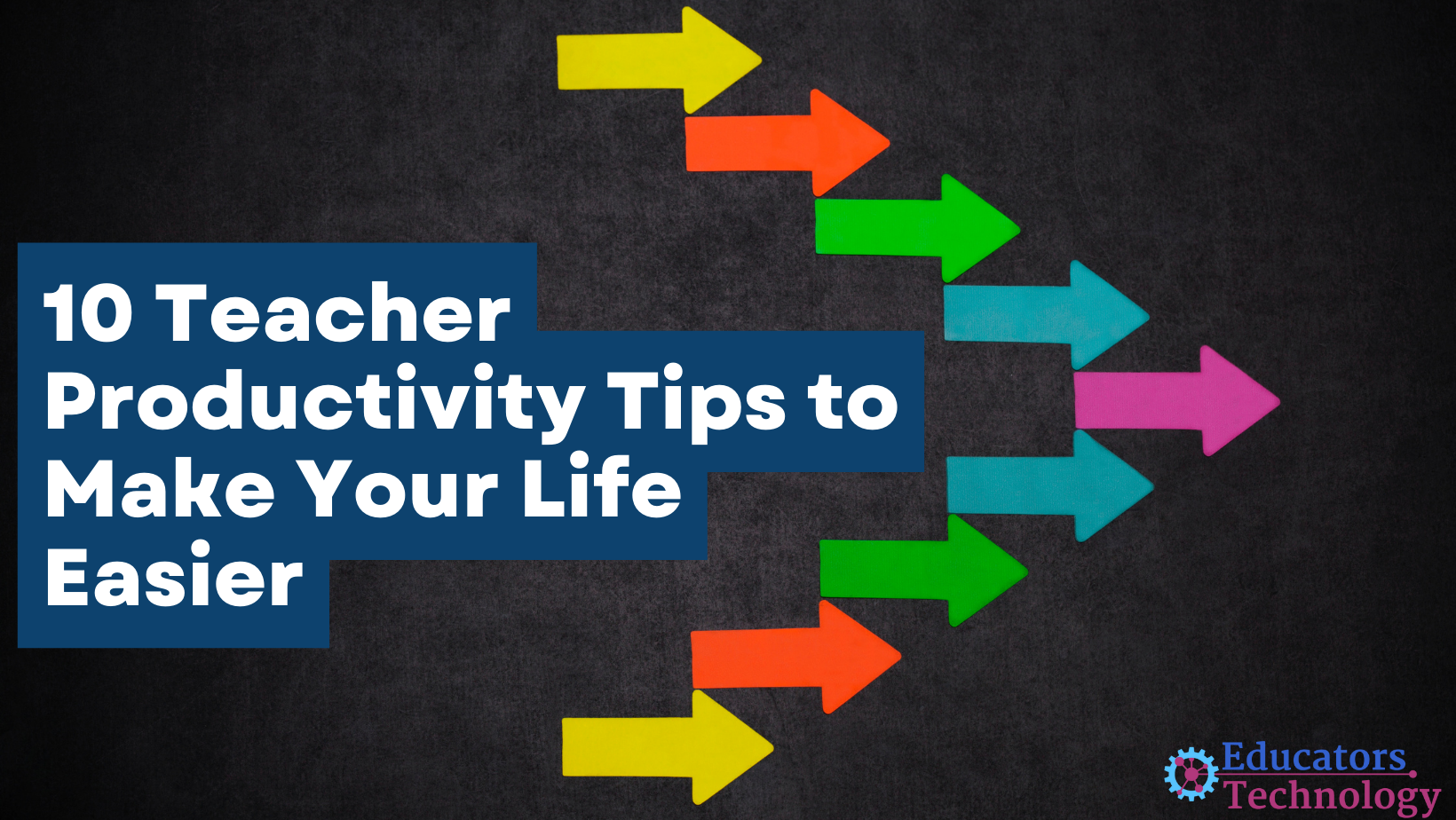Teaching may be a rewarding profession, but it also requires balancing various responsibilities. From crafting engaging lesson plans to managing classroom dynamics and communicating with parents, teachers contend with a diverse array of tasks daily. This article will offer ten actionable tips to improve teacher productivity and establish a healthier work-life balance.
 1. Improve Time Management
1. Improve Time Management
It’s no secret that teachers have a lot on their plates, and how they manage their time can make a huge difference in their productivity. Here are some practical time management tips that you may find valuable:
Prioritize Tasks: To make your day as productive as possible, start by identifying the most important tasks. This way, you ensure you tackle the key responsibilities upfront.
Batch Similar Tasks: You can bundle similar tasks to make your work more efficient. Instead of constantly switching between different types of activities, try to tackle similar tasks during the same time block. For example, set aside a specific time for grading assignments or responding to emails. This reduces mental effort and helps you work more efficiently.
Use Time Tracking Tools: Consider using free time tracking software like traqq.com to monitor how you spend your time. This tool lets you understand your daily routines and habits better. It helps you see where you might be spending more time than expected and how you can work smarter.
Use Templates: Designing templates for your lesson plans, worksheets, and presentations can be a big time-saver. This not only simplifies the planning process but also keeps your materials consistent.
Weekly Lesson Planning: Set aside a specific time each week dedicated solely to lesson planning. Staying consistent will help you avoid last-minute rushes. By planning your lessons on a regular schedule, you’ll have ample time to brainstorm creative ideas, gather necessary resources, and ensure your lessons are engaging and well-prepared.
2. Utilize Technology
In today’s digital age, technology offers a treasure trove of resources and solutions to enhance teacher productivity. You don’t have to be a tech wizard to benefit from these tech tools. Here are a few suggestions:
Learning Management Systems (LMS): LMS platforms like Google Classroom, Moodle, or Canvas are a teacher’s best friend. You can create digital classrooms, share resources, collect assignments, and even communicate with students all in one place.
Digital Grading Tools: Consider using grading software such as Turnitin or Gradescope. They can grade multiple-choice questions and give feedback on written assignments automatically. This frees up your time from manual grading, so you can concentrate on more meaningful aspects of teaching.
Collaborative Cloud Tools: Tools like Google Workspace and Microsoft Office 365 enable collaboration on documents, presentations, and spreadsheets. You and your students can work together in real time, even from different locations.
Online Assessment Platforms: Platforms like Kahoot! or Quizlet offer engaging ways to evaluate how well students understand the material. You can create quizzes, flashcards, and interactive games to make learning fun and informative.
Screencasting and Video Tools: Tools like Screencast-O-Matic or Loom let you create video lessons, tutorials, or explanations. These can be especially helpful for flipped classrooms or providing additional resources to students who need them.
3. Collaborate with Other Teachers
Collaboration is a valuable way for teachers to share knowledge and experiences. Teachers can exchange lesson plans, worksheets, and materials they’ve created. This not only saves time but also offers a variety of resources for different students.
Additionally, collaboration builds a sense of community among educators. Teaching can sometimes be a lonely job, but through collaboration, you become part of a supportive network. You can rely on your colleagues for guidance, motivation, and even a bit of humor when times get tough.
4. Prioritize Self Care
Without a healthy work-life balance and self-care routine, it’s easy to burn out. And a burnt-out teacher isn’t as effective in the classroom. So, let’s look at some strategies to maintain that balance:
Prioritize Your Well-being: Keep in mind that your health is important. Make time for physical exercise, nutritious meals, and enough sleep. It’s not just about physical well-being; it also impacts your mental resilience.
Take Short Breaks: Throughout your workday, take short breaks to recharge. Even a 10-minute walk or a moment of deep breathing can help you reset and stay focused.
Unplug Regularly: Give yourself tech breaks. Step away from emails and screens, especially during your personal time.
Plan Relaxation: Just as you plan your lessons, schedule time for relaxation or hobbies. This could be reading a book, gardening, or any activity you enjoy. Having something to look forward to outside of work can be motivating.
Ask for Support: Don’t be afraid to reach out to your colleagues or a counselor if you feel overwhelmed. Sometimes, discussing your difficulties can offer fresh insights and answers.
5. Streamline Communication
Communication with students, parents, and colleagues can take a lot of time. To streamline this process, consider using these tools and techniques:
Set Communication Hours: Inform students, parents, and colleagues about your preferred communication hours. Stick to these hours to maintain a steady communication schedule that respects your availability and allows you to concentrate on work and personal matters.
Use Templates: Save time on repetitive communications by creating templates for common messages, such as welcome emails or assignment instructions. Customize these templates as needed for individual recipients.
Use Communication Platforms: Besides email, you can use messaging apps like Remind or Slack to easily communicate with students, parents, or colleagues. These apps facilitate quick updates, answering questions, and sharing important information.
Emphasize the Importance of Communication: In your classroom or workplace, stress the value of effective communication. Teach students communication skills and establish clear guidelines for respectful and productive interactions.
6. Avoid Multitasking
Many people believe they’re efficient multitaskers, but various researches show that the human brain isn’t designed for it. If we switch between tasks, our brains have to work harder to focus. It can lead to mistakes, lower-quality work, and more stress.
How to avoid multitasking? Start by prioritizing your tasks. Identify the most important one, tackle it first, and move on to the next. Set specific blocks of time for different activities, and try your best to follow your schedule closely.
7. Organize Workspace
Effective organization across home, school, and digital spaces is essential for teacher productivity. It saves valuable time, reduces stress and fosters a healthier work-life balance. Let’s explore how you can effectively organize your workplace in various settings:
Organizing Your Workplace at Home:
-
Designate a Workspace: Set up a dedicated workspace at home where you can focus on grading, lesson planning, and administrative tasks. Keep it organized with essential supplies within reach.
-
Declutter Regularly: Allocate regular time to tidy up your home workspace. Get rid of things you no longer need or use. A clutter-free space helps clear your mind and boost productivity.
-
Personalize Your Space: Make your home workspace comfortable and inspiring. Add personal touches like plants or artwork. A warm and inviting setting can enhance your mood and motivation.
Organizing Your Workplace at School:
-
Streamlined Student Work: Create a system for collecting, organizing, and returning student work. Use labeled bins or folders for each student or assignment.
-
Visual Aids: Use labeled bins, drawers, and shelves for organizing your materials and supplies. Visual cues can help you quickly locate what you need during lessons.
-
Teacher Toolkit: Create a “teacher toolkit” with essential supplies like pens, markers, and sticky notes. Having these items available can save time during lessons and activities.
-
Emergency Kit: Keep a well-organized emergency kit or first-aid supplies in your classroom. Make sure everyone knows where it is and how to use it in case of unexpected situations.
Organizing Your Digital Space:
-
Email Management: Create folders or labels to categorize emails from students, parents, and colleagues.
-
Cloud Storage: Use secure cloud storage solutions such as Google Drive or Dropbox to store and access digital teaching resources from any location. Organize files with clear naming conventions.
-
Calendar Integration: Sync your digital calendar with school events, meetings, and personal commitments. Color-code entries for easy reference.
8. Create Effective To-Do Lists
Creating an effective to-do list is a valuable skill that can boost teacher productivity. Here’s how to create one that works:
Start with a Brain Dump: Begin by jotting down everything that comes to mind. Write down all tasks and responsibilities, no matter how small or large. This brain dump helps you capture everything you need to do.
Prioritize Tasks: Once you have your list, prioritize tasks based on importance. Use a numbering system or symbols like “High Priority,” “Medium Priority,” and “Low Priority.”
Break Down Big Tasks: Large, daunting tasks can be overwhelming. Break them into subtasks to make them more approachable and less intimidating.
Set Realistic Goals: Be practical about what you can get done in a day. Avoid overloading your to-do list, as it can lead to frustration and a sense of failure if you can’t complete everything.
Use Specific Language: Write clear and specific task descriptions. Vague tasks like “Work on lesson plan” can be confusing. Instead, write “Create an outline for tomorrow’s history lesson” or “Gather relevant resources for the science experiment on Thursday.”
Include Deadlines: Set deadlines or due dates for tasks. This helps you stay accountable and ensures that important tasks are completed on time.
Use a To-Do List Tool: Consider using digital to-do list apps like Todoist or Microsoft To-Do. These tools offer features like due date reminders and cross-platform access to help you stay organized.
9. Learn to Say No
It’s okay to politely say no to extra responsibilities when your schedule is full. Overcommitting can lead to stress and compromise the quality of your work. It’s wiser to excel in a few areas than to overextend yourself.
Before taking on new tasks or projects, pause and evaluate your current workload and availability. Think about the time and effort needed for existing commitments. This evaluation helps you make informed decisions about what you can realistically handle.
10. Establishing Clear Classroom Routines
One of the foundations of a well-managed classroom is establishing clear routines. This means setting expectations for how students should enter, leave, and behave during class. You might have a routine for collecting homework, starting each lesson, or transitioning between activities.
Here are a couple of examples:
1. Consider having a routine for how students should request help or clarification during independent work. They may raise a hand or place a designated help card on their desk. This will allow you to address questions without interrupting the flow of the entire class.
2. You may establish a routine for collecting and returning homework. For example, tell students that assignments are always due at the beginning of class on Mondays, and you return graded assignments on Wednesdays. This consistency will help them plan and manage their responsibilities.
Conclusion
I trust that you’ve discovered these tips to be valuable in enhancing teacher productivity. By mastering these strategies, teachers can strike a balance between productivity and well-being, fostering an environment where both educators and students thrive.
The post 10 Tips to Increase Teacher Productivity appeared first on Educators Technology.











 1. Improve Time Management
1. Improve Time Management
